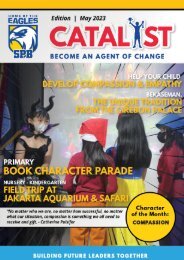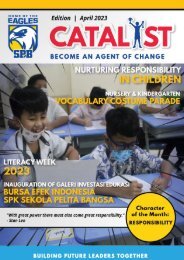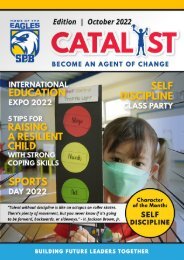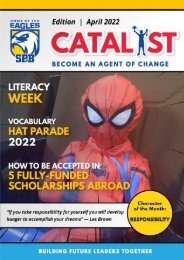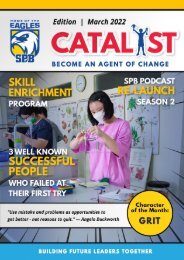SPB News June - July 2018
Monthly insight of student and teacher activities at Sekolah Pelita Bangsa Cirebon
Monthly insight of student and teacher activities at Sekolah Pelita Bangsa Cirebon
You also want an ePaper? Increase the reach of your titles
YUMPU automatically turns print PDFs into web optimized ePapers that Google loves.
Encourage Your<br />
Child’s Creativity<br />
Once you’ve provided your child with the<br />
tools that inspire creativity, stand back<br />
and let him loose, even if things are likely<br />
to get rather messy. Preschoolers tend to<br />
focus more on process than on product.<br />
They throw themselves into exploring the<br />
properties and possibilities of materials<br />
like paint, mud, sand, water, and glue<br />
without worrying about the results. In fact,<br />
when your 3-year-old proudly displays his<br />
latest masterpiece, you should try not to<br />
ask, “What is it?” That question may have<br />
never even occurred to him.<br />
Instead, admire the work for what it is:<br />
“That’s really wonderful! Tell me just how<br />
you did it.” Then, encourage him to explain<br />
to you in his own words how he felt and<br />
what he was thinking about while he was<br />
making it.<br />
The less control you try to impose over<br />
your child’s creativity, the better. This<br />
advice especially holds true when it<br />
comes to the hand your child favors.<br />
One of the milestones of this age is<br />
becoming right-handed or left-handed. In<br />
fact, handedness is an important sign of<br />
increasing brain organization. By age 4,<br />
some 90 percent of children have become<br />
clearly right-handed, while the rest have<br />
become dedicated southpaws.<br />
The main determinant of handedness is<br />
heredity, so it’s best not to tamper with<br />
your child’s genetic predisposition. Lef<br />
t-handers are no less socially acceptable<br />
than righties. And when pressure from<br />
parents or preschool teachers induces<br />
a child to switch, doing so usually takes<br />
a long-term toll in emotional upset and<br />
poor coordination.<br />
So let your child lead the way.<br />
And don’t be alarmed if her fine motor<br />
skills progress more slowly than her<br />
gross motor development because<br />
the kinds of delicate movements that<br />
enable children to manipulate objects<br />
(stacking and nesting blocks or putting<br />
together puzzle pieces, for example)<br />
can be learned only over time with a lot<br />
of practice. Unfortunately, while most<br />
3-year-olds will run happily for hours on a<br />
playground, few really have the patience<br />
to sit and copy a drawing of a circle or<br />
a cross over and over. And keep in mind<br />
that the smaller muscles of the body<br />
(like those in the hands and fingers) tire<br />
out more easily than the larger muscles<br />
in the arms and legs, so endurance<br />
and strength must be built up gradually<br />
before your child’s dexterity can improve.<br />
Fine motor skills are closely linked to<br />
cognitive development. In order to build a<br />
fort with blocks, for instance,<br />
a child must be able to think in a three<br />
-dimensional manner. Adding limbs,<br />
hair, or facial features to an incomplete<br />
picture of a person means that your child<br />
is capable of understanding that twodimensional<br />
drawings can symbolize<br />
real people. Your child must mentally<br />
compare the picture with stored images<br />
of what people look like to figure out<br />
what’s missing from the drawing, and he<br />
must be able to manipulate a pencil or<br />
crayon well enough to fill in the absent<br />
features. The thought process involved<br />
in such acts is far more complicated<br />
than that for figuring out how to climb a<br />
ladder, chase a ball, or walk out a door.<br />
So it’s important for you to be patient,<br />
encouraging, and supportive of your<br />
child’s efforts. Whatever he masters<br />
today will stand him in good stead<br />
once he starts more formal learning in<br />
kindergarten and beyond.<br />
Source: https://www.parents.com/toddlers-preschoolers/development/physical/child-developing-motor-skills/




